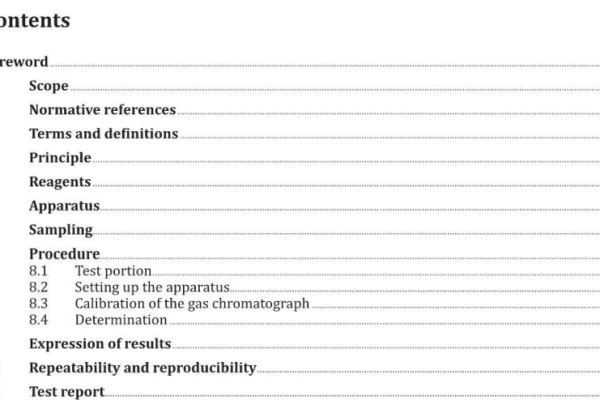ISO 20714:2019 pdf download – E-liquid – Determination of nicotine, propylene glycol and glycerol in liquids used in electronic nicotine delivery devices – Gas chromatographic method.
5.4 Internal standards of high purity: quinaldine [ CAS: 91-63-4 ], 1,3-butanediol (CAS: 107-88-0), n-heptadecane (CAS: 629-78-7), n-octadecane (CAS: 593-45-3). Anethol and other appropriate internal standards may be used after assessment of their purity and determination that the internal standard does not co-elute with other components in the dilution. The peak area of the internal standard on samples should be monitored for consistency. In cases where inconsistencies are found, analysis of a diluted sample without the internal standard should be performed to confirm the absence of a peak in the extract eluting at the same time as the internal standard. 5.5 Dilution solution: isopropanol ( .5…3. ) containing an appropriate concentration of the internal standard 0,2 mg/ml of quinaldine, 1 mg/ml of 1,3-butanediol, 1 mg/ml of n-heptadecane or 1 mg/ml of n-octadecane 5.6 Reference substances 5.6.1 Nicotine (CAS: 54-11-5 ], of known purity not less than 98 %. Nicotine salicylate (CAS: 29790- 52-1 ] of known purity not less than 98 % may also be used. NOTE The purity of the nicotine or nicotine salicylate can be verified using ISO 13276 or by any other validated method. 5.6.2 Propylene glycol [ CAS: grade, minimum purity 99 %. 5.6.3 Glycerol [ CAS : 56-81-5), analytical grade, minimum Store these reference substances at a temperature in accordance with the manufacturer ’ s recommendation. 5.7 Calibration solutions Prepare a series of at least five calibration solutions with concentrations that cover the range of expected levels to be found in the test portion by adding weighed amounts of nicotine [ .5…6…1 ), propylene glycol and glycerol the dilution solution The following linear ranges were used in the collaborative study: 0,005 mg/ml to 1,5 mg/ml for nicotine, 0,12 mg/ml to 10 mg/ml for propylene glycol and glycerol. Store these solutions between and in a dark environment. Solutions stored at low temperatures shall be allowed to equilibrate to room temperature before use. 6 Apparatus Usual l aboratory apparatus and, in particula r, the following items. 6.1 Gas chromatograph, equipped with a flame ionization detector, recorder, integrator or data handling system. 6.2 Capillary column DB-ALC11l capillary column [ 30 m length × 0,32 mm ID, 1,8 µm film thickness) has been found to be satisfactory. Alternative capillary columns (such as a WAX column) may be used provided that the peaks for solvent, internal standards, nicotine, propylene glycol, glycerol and other e-liquids components are well resolved which can require optimization of the instrument conditions.
7 Sampling Carry out sampling according to a suitable procedure. 8 Procedure 8.1 Test portion Allow sample to equilibrate to room temperature before opening. Weigh, to the nearest 0,001 g, 0,1 g of the sample into the dilution vessel. BS ISO 20714:2019 ISO 20714:2019(E) Pipette 10 ml of dilution solution the dilution vessel, immediately seal the vessel and mix well. Tr ansfer the solution into a gas chromatography vial and cap the vial. Analysis should be performed as soon as possible, but if storage is inevitable then store the sample at between and in a dark environment until gas chromatography analysis.
ISO 20714:2019 pdf download – E-liquid – Determination of nicotine, propylene glycol and glycerol in liquids used in electronic nicotine delivery devices – Gas chromatographic method






